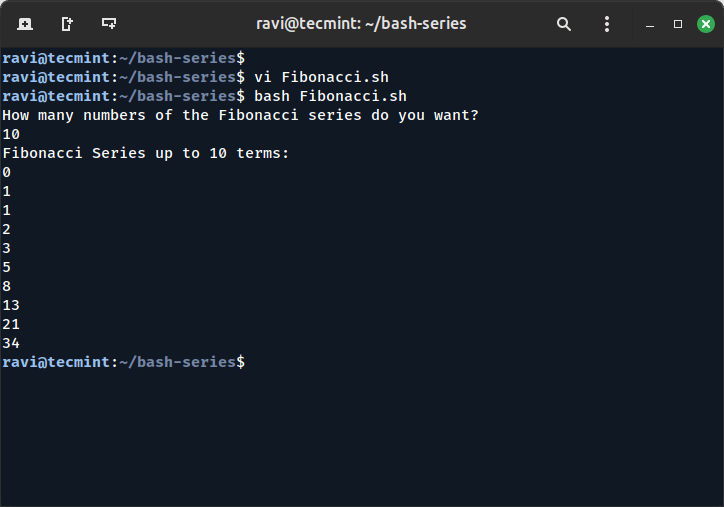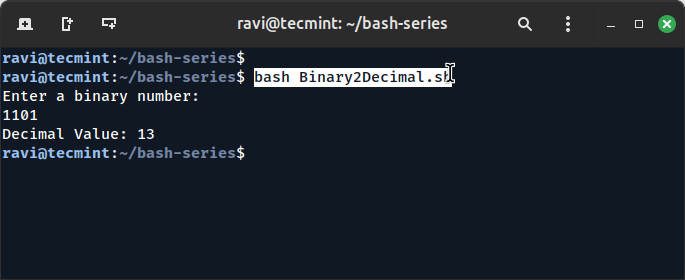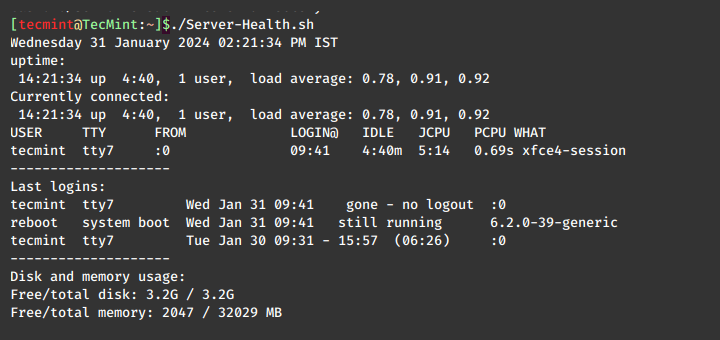By now, you must be feeling a bit more confident writing and understanding basic shell scripts. If you’ve followed the previous parts of this tutorial series, you’re already familiar with variables, loops, conditions, and simple operations in shell scripting.
This is the fifth part of this shell scripting tutorial series. In this post, we’ll explore slightly advanced mathematical operations and how to handle them using shell scripts.
Let’s Start with the Fibonacci Series
The Fibonacci series is a sequence of numbers where each number is the sum of the two preceding ones. It starts with 0 and 1, so the series goes: 0, 1, 1, 2, 3, 5, 8, and so on.
Script 1: Fibonacci.sh
#!/bin/bash
echo "How many numbers of the Fibonacci series do you want?"
read total
# Initialize the first two numbers
x=0
y=1
echo "Fibonacci Series up to $total terms:"
# Print the first two numbers
echo "$x"
echo "$y"
# Loop starts from the 3rd term
i=2
while [ $i -lt $total ]
do
z=$((x + y)) # Next number is sum of previous two
echo "$z"
x=$y
y=$z
i=$((i + 1))
done

Decimal to Binary Conversion
Every computer understands binary: only 0s and 1s. Here’s how you can write a shell script to convert a Decimal number (like 10) to Binary (1010).
Script 2: Decimal2Binary.sh
#!/bin/bash
# Create an array of powers of 2 (2^31 to 2^0)
for ((i=32;i>=0;i--)); do
power=$((2**i))
powersOfTwo+=( $power )
done
# Check if input was provided
if [ $# -eq 0 ]; then
echo -e "Usage: ./Decimal2Binary.sh <number1> <number2> ..."
exit 1
fi
echo -e "Decimal\t\tBinary"
# Convert each number to binary
for num in "$@"; do
binary=""
started=0
for pow in "${powersOfTwo[@]}"; do
if [ $num -lt $pow ]; then
if [ $started -eq 1 ]; then
binary+="0"
fi
else
binary+="1"
num=$((num - pow))
started=1
fi
done
echo -e "$1\t\t$binary"
done

Want a quicker way? use the bc command, which will convert a decimal number to binary in a single line of code.
echo "obase=2; NUM" | bc
Replace NUM with the decimal number you want to convert to binary.
echo "obase=2; 121" | bc
This will output the binary equivalent of 121, which is 1111001.
Binary to Decimal Conversion
Next, we will write a script that performs the opposite of the above script, converting binary values to decimal.
Script 3: Binary2Decimal.sh
#!/bin/bash
echo "Enter a binary number:"
read Binary
# Check if input is a valid binary number
if ! [[ $Binary =~ ^[01]+$ ]]; then
echo "Please enter a valid binary number (only 0 and 1 allowed)."
exit 1
fi
Decimal=0
power=1
# Loop from right to left
while [ $Binary -ne 0 ]; do
digit=$((Binary % 10))
Decimal=$((Decimal + digit * power))
power=$((power * 2))
Binary=$((Binary / 10))
done
echo "Decimal Value: $Decimal"

The above conversion can be performed directly in the terminal using the bc command as follows:
echo "ibase=2; BINARY" | bc
Simply replace BINARY with the binary number you want to convert.
echo "ibase=2; 11010101" | bc
This will output the corresponding decimal value.
Other Number Base Conversions Using bc Command
Similarly, you can write scripts to convert between octal, hexadecimal, and decimal, both ways. You can also accomplish these conversions directly in the terminal using the bc command.
Decimal to Octal
echo "obase=8; 123" | bc
Decimal to Hexadecimal
echo "obase=16; 123" | bc
Octal to Decimal
echo "ibase=8; 173" | bc
Hexadecimal to Decimal
echo "ibase=16; 7B" | bc
Binary to Octal
echo "ibase=2; obase=8; 101101" | bc
Common Numeric Tests in Shell Scripting
Use these tests inside if statements to compare numbers.
| Test Command | Meaning |
|---|---|
[ $a -eq $b ] |
a is equal to b |
[ $a -ne $b ] |
a is not equal to b |
[ $a -gt $b ] |
a is greater than b |
[ $a -lt $b ] |
a is less than b |
[ $a -ge $b ] |
a is greater than or equal to b |
[ $a -le $b ] |
a is less than or equal to b |
Conclusion
In this fifth part of our shell scripting tutorial series, we’ve ventured into slightly more advanced mathematical operations, focusing on converting numbers between different bases and calculating the Fibonacci series.
By now, you should feel more confident in handling basic mathematical operations in shell scripts, like generating the Fibonacci sequence and performing conversions between decimal, binary, octal, and hexadecimal number systems.







You got a typo in script2
@Ian,
Can you point us the typo? so that we can correct it..